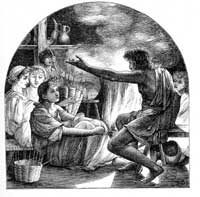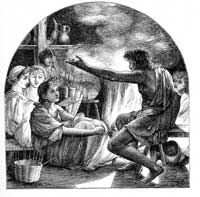As I wr ote in my last post “Transmedia Storytelling: The Reemergence of Fundamentals“, Transmedia storytelling is very exciting, but it isn’t new. It is the ultimate mashup of ancient traditions and new communications models. There have been stories and messages delivered across different media every since the Cro-Magnon man figured out that mineral pigments like iron oxide and black manganese could be applied to the sides of rocks and caves. Whether chronicling life, communicating with others, or creating an inspirational image, there were stories being told. Media technologies have come a long way since cave painting and have so many new capabilities, that the orchestration of a story across multiple media platforms can be a complex creative endeavor. This is was a significant enough shift in application that in April 2010, the Producers Guild of America added a transmedia producer designation so the producers who expand a storyline onto three or more platforms can get credit.
ote in my last post “Transmedia Storytelling: The Reemergence of Fundamentals“, Transmedia storytelling is very exciting, but it isn’t new. It is the ultimate mashup of ancient traditions and new communications models. There have been stories and messages delivered across different media every since the Cro-Magnon man figured out that mineral pigments like iron oxide and black manganese could be applied to the sides of rocks and caves. Whether chronicling life, communicating with others, or creating an inspirational image, there were stories being told. Media technologies have come a long way since cave painting and have so many new capabilities, that the orchestration of a story across multiple media platforms can be a complex creative endeavor. This is was a significant enough shift in application that in April 2010, the Producers Guild of America added a transmedia producer designation so the producers who expand a storyline onto three or more platforms can get credit.
Even with technology’s increasingly sophisticated and jaw-dropping capabilities, the tools are becoming simultaneously more accessible and user-friendly. So much so, that the boundaries are blurring not just across technologies but also across the people who are creating, using, producing, augmenting, distributing, hacking, mashing, and every other ‘-ing’ imaginable.
In spite of all the excitement, however, the human brain has been on a slower evolutionary trajectory than the technology. Our brains still respond to content by looking for the story to make sense out of the experience. No matter what the technology, the meaning starts in the brain. The transmedia producer may get the credit line, but the success of the transmedia effort rests on the resonance, authenticity, and richness created by the storyteller.
Stories are authentic human experiences. Stories leap frog the technology and bring us to the core of experience, as any good storyteller (transmedia or otherwise) knows. There are several psychological reasons why stories are so powerful.
- Stories have always been a primal form of communication. They are timeless links to ancient traditions, legends, archetypes, myths, and symbols. They connect us to a larger self and universal truths.

- Stories are about collaboration and connection. They transcend generations, they engage us through emotions, and they connect us to others. Through stories we share passions, sadness, hardships and joys. We share meaning and purpose. Stories are the common ground that allows people to communicate, overcoming our defenses and our differences. Stories allow us to understand ourselves better and to find our commonality with others.
- Stories are how we think. They are how we make meaning of life. Call them schemas, scripts, cognitive maps, mental models, metaphors, or narratives. Stories are how we explain how things work, how we make decisions, how we justify our decisions, how we persuade others, how we understand our place in the world, create our identities, and define and teach social values.
- Stories provide order. Humans seek certainty and narrative structure is familiar, predictable, and comforting. Within the context of the story arc we can withstand intense emotions because we know that resolution follows the conflict. We can experience with a safety net.
- Stories are how we are wired. Stores take place in the imagination. To the human brain, imagined experiences are processed the same as real experiences. Stories create genuine emotions, presence (the sense of being somewhere), and behavioral responses.
- Stories are the pathway to engaging our right brain and triggering our imagination. By engaging our imagination, we become participants in the narrative. We can step out of our own shoes, see differently, and increase our empathy for others. Through imagination, we tap into creativity that is the foundation of innovation, self-discovery and change.
Social media technologies have created a demand for fundamentals: authenticity, participation, and engagement. Special effects and funny Super Bowl ads are fine, but they are expensive one-offs if they do not touch the core of experience. I don’t care how you calculate, that’s not going to get you a very good ROI. When organizations, causes, brands or individuals identify and develop a core story, they create and display authentic meaning and purpose that others can believe, participate with, and share. This is the basis for cultural and social change. This is a skill worth learning.
—
Bonnie and I frequently give workshops and presentations on transmedia storytelling and finding your story for corporate, nonprofit, and advocacy groups. We are also teaching Transmedia Marketing through Storytelling at UC Irvine Extension.

 Dr. Pamela Rutledge is available to reporters for comments on the psychological and social impact of media and technology on individuals, society, organizations and brands.
Dr. Pamela Rutledge is available to reporters for comments on the psychological and social impact of media and technology on individuals, society, organizations and brands.
[…] This post was mentioned on Twitter by Dani Seuba. Dani Seuba said: RT @CampfireNYC: Transmedia Storytelling is a much stickier trend than Augmented Reality. http://bit.ly/ic16Ha […]
[…] Transmedia Storytelling :: The Psychological Power of Story […]
[…] People connect with the world around them through stories. […]